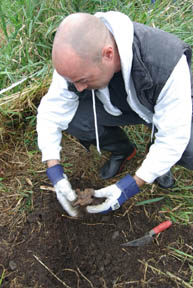Bourguignon Beat: Ashes to ashes, dust to dung
Bourguignon Beat: Ashes to ashes, dust to dung McGill University
User Tools (skip):
BOURGUIGNON BEAT
Ashes to ashes, dust to dung
Tagging along on an elephant dig

Intrepid reporter Michael Bourguignon takes a moment away from the muck to marvel at the first of several bones the team will find in its search for Magic, the elusive elephant.
Ieva Paberzyte
There's almost nothing a dedicated reporter won't do to get to the truth, even if the truth happens to be buried under layer upon layer of mud and exotic animal feces.
The truth, in this case, is the whereabouts of a seven-ton, 13-foot-tall African elephant who met his maker by way of cardiac arrest some seven years ago and now lies somewhere in a burial ground at the Parc Safari theme park.
Officials from the exotic zoo in Hemmingford, a rural community about 45 minutes south of Montreal, had approached McGill University anthropology professor Andre Costopoulos with a novel proposal: help locate the remains of a rhinoceros, an elephant and perhaps a macaque or two so that the skeletons can be reassembled and put on display for educational purposes. The benefit to McGill would be a unique opportunity for 17 exuberant students to gain field experience in the excavation of things they never expected to excavate on this continent.
Things like Alice, the rhinoceros buried just a couple of years ago in one of the park's two burial grounds, which Costopoulos and his team unearthed recently.
Graduate student Tabatha McKell, one of the teaching assistants in the newly created Archaeological Field Methods course, and one of the students who found Alice, won't soon forget the experience.
"We were digging with our shovels, and at about 50 centimetres down, we noticed a change in the earth - it went from brown to grey. At that point, we knew there was something there, so we started using our trowels and stumbled onto the rhinoceros. And then we smelled it."
The smell, according to all who were there, was unmistakable: "Like a toilet." The carcass still had flesh on the bones and was, in Costopoulos' words, "pretty juicy."
The search for Magic the elephant would prove to be no less fragrant.
I knew this would be a unique opportunity, and I had a lot of questions.
For starters, what does one wear to an elephant excavation?
"Rubber boots and stuff you'll never want to wear again," Costopoulos advises me. Most of the students have dig pants and other items of clothing they reserve only for occasions such as this. Once on-site, it doesn't take me long to figure out why, particularly as I have already started to pick up the lingo. For instance, when applied to soil, the term "intensely organic" means "lots of poo."
Before we could start digging, Costopoulos and his crew needed to survey the site, getting the lay of the land and the state of its vegetation and figuring out how to proceed from there.
"There's a bump here, which is good-if you're going to bury an elephant, you're going to have a lot of earth left over," Costopoulos observes. "Next to it is a flat area, so I think that might be a good place to start."
The first step is to measure out a line along which to dig a series of test pits roughly 50 centimetres in diameter and five metres apart. It's grueling, messy and, above all, stinky work. It quickly becomes obvious, that the site was once used as a dung heap.
Within five minutes, the team has found its first bone: a segment of backbone belonging to some unusual animal or other. Not even Susan Lofthouse, a PhD student in zooarchaeology and specialist in bone identification, can say for sure.
Nor can zoo director Patrice Deneault, who tells us the cemetery is home to zebras, giraffes, monkeys and other animals that have died at the park over the years. Not to mention feedbags, lengths of rope and other zoological detritus.
When asked the inevitable, Deneault explains that incinerating animal remains is too costly for most zoos-something in the order of $2,500 per 1,000 pounds-and the nearest incinerator is in Ste. Hyacinthe, which means additional transportation costs.
More bones will be found and tagged over the course of a few hours, and by 4 p.m., real excitement erupts when what looks to be an elephant tusk emerges. Deneault informs us that it is, in fact, the horn of a watusi, an African cattle species. It's not the elephant we've been looking for, but it's no less exciting.
There would be, of course, many disappointments throughout the day. As student Dave Groves observed: "Ninety-nine percent of the time, you'll get really excited about something you've found, and it turns out to be a rock." Or yet another piece of petrified poo.
Costopoulos predicts the excavation work could go on for years, especially since Deneault has no plans to apply the brakes anytime soon and is happy to do his part for the greater good. "If they're able to do the work, and we find five giraffes, there's no reason we couldn't give one to the Redpath Museum," Deneault says.
They hope to find the elephant sooner rather than later, but in the meantime, for some of these students, squishing around in all this muck is almost a dream come true, the culmination of a lifetime of curiosity.
"If you had told me when I was six that I would someday get the chance to dig up an elephant, I would never have believed you," student Sol Klein says. Neither would I.
Michael Bourguignon, a communications officer and intrepid reporter in McGill's Media and University Relations Office, regularly ventures into the University's lesser-known corners and classrooms to share offbeat experiences with Reporter readers.

